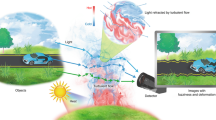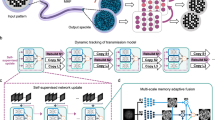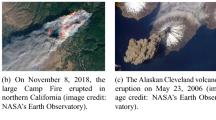Abstract
Turbulence exists widely in the natural atmosphere and in industrial fluids. Strong randomness, anisotropy and mixing of multiple-scale eddies complicate the analysis and measurement of atmospheric turbulence. Although the spatially integrated strength of atmospheric turbulence can be roughly measured indirectly by Doppler radar or laser, direct measurement of two-dimensional (2D) strength fields of atmospheric turbulence is challenging. Here we attempt to solve this problem through infrared imaging. Specifically, we propose a physically boosted cooperative learning framework, termed the PBCL, to quantify 2D turbulence strength from infrared images. To demonstrate the capability of the PBCL, we constructed a dataset with 137,336 infrared images and corresponding 2D turbulence strength fields. The experimental results show that cooperative learning brings performance improvements, enabling the PBCL to simultaneously learn turbulence strength fields and inhibit adverse turbulence effects in images. Our work demonstrates the potential of imaging in measuring physical quantity fields.
This is a preview of subscription content, access via your institution
Access options
Access Nature and 54 other Nature Portfolio journals
Get Nature+, our best-value online-access subscription
$29.99 / 30 days
cancel any time
Subscribe to this journal
Receive 12 digital issues and online access to articles
$99.00 per year
only $8.25 per issue
Buy this article
- Purchase on Springer Link
- Instant access to full article PDF
Prices may be subject to local taxes which are calculated during checkout






Similar content being viewed by others
Data availability
Our data include real data and simulated data. The real data were recorded by a infrared camera in outdoor atmospheric turbulence environment. The simulation data were synthesized by simulating the atmospheric turbulence effects on infrared images. The real data used in this paper and the full simulated data are publicly available in a Zenodo repository at https://doi.org/10.5281/zenodo.8002688 ref. 43. Source data are provided with this paper.
Code availability
The code presented in this article is publicly available through a Code Ocean compute capsule at https://doi.org/10.24433/CO.9167814.v1 ref. 44.
References
Qi, Y. et al. Fragmentation in turbulence by small eddies. Nat. Commun. 13, 1–8 (2022).
Iyer, K. P., Bonaccorso, F., Biferale, L. & Toschi, F. Multiscale anisotropic fluctuations in sheared turbulence with multiple states. Phys. Rev. Fluids 2, 052602 (2017).
Nakayama, Y. Introduction to Fluid Mechanics (Butterworth-Heinemann, 2018).
Eames, I. & Flor, J.-B. New developments in understanding interfacial processes in turbulent flows. Phil. Trans. R. Soc. A 369, 702–705 (2011).
Dutton, J. A. & Panofsky, H. A. Clear air turbulence: a mystery may be unfolding: high altitude turbulence poses serious problems for aviation and atmospheric science. Science 167, 937–944 (1970).
Sathe, A. & Mann, J. A review of turbulence measurements using ground-based wind lidars. Atmos. Meas. Tech. 6, 3147–3167 (2013).
Toselli, I., Andrews, L. C., Phillips, R. L. & Ferrero, V. Free-space optical system performance for laser beam propagation through non-Kolmogorov turbulence. Opt. Eng. 47, 026003 (2008).
Ramlau, R. & Rosensteiner, M. An efficient solution to the atmospheric turbulence tomography problem using Kaczmarz iteration. Inverse Probl. 28, 095004 (2012).
Alterman, M., Schechner, Y. Y., Vo, M. & Narasimhan, S. G. Passive tomography of turbulence strength. In European Conference on Computer Vision 47–60 (Springer, 2014).
Kolmogorov, A. N. Dissipation of energy in the locally isotropic turbulence. Proc. R. Soc. Lond. Ser. A 434, 15–17 (1991).
Moore, R. L. & Krishnamurti, T. N. Atmospheric clear air turbulence. Nature 209, 462–463 (1966).
Engelmann, R. et al. Lidar observations of the vertical aerosol flux in the planetary boundary layer. J. Atmos. Ocean. Technol. 25, 1296–1306 (2008).
Zhu, X. & Kahn, J. M. Free-space optical communication through atmospheric turbulence channels. IEEE Trans. Commun. 50, 1293–1300 (2002).
Pipinato, A. Innovative Bridge Design Handbook: Construction, Rehabilitation and Maintenance (Elsevier, 2021).
Wu, S. et al. Measurement and analysis of atmospheric optical turbulence in Lhasa based on thermosonde. J. Atmos. Sol. Terr. Phys. 201, 105241 (2020).
Jaiswal, A., Phanikumar, D., Bhattacharjee, S. & Naja, M. Estimation of turbulence parameters using ARIES ST radar and GPS radiosonde measurements: first results from the central Himalayan region. Radio Sci. 55, 1–18 (2020).
Clark, T. L. et al. Origins of aircraft-damaging clear-air turbulence during the 9 December 1992 Colorado downslope windstorm: numerical simulations and comparison with observations. J. Atmos. Sci. 57, 1105–1131 (2000).
Frehlich, R. Simulation of laser propagation in a turbulent atmosphere. Appl. Opt. 39, 393–397 (2000).
Browning, K. & Watkins, C. Observations of clear air turbulence by high power radar. Nature 227, 260–263 (1970).
Qiang, X. et al. Measurement of the inner scale of laboratory-simulated atmospheric turbulence. In Asia Communications and Photonics Conference and Exhibition 1–2 (IEEE, 2009).
Megaw, E. Scattering of electromagnetic waves by atmospheric turbulence: stellar scintillation and the spectrum of turbulence in the free atmosphere. Nature 166, 1100–1101 (1950).
Lohse, D. & Xia, K.-Q. Small-scale properties of turbulent Rayleigh–Bénard convection. Annu. Rev. Fluid Mech. 42, 335–364 (2010).
Cui, L., Xue, B. & Zhou, F. Atmospheric turbulence MTF for infrared optical waves’ propagation through marine atmospheric turbulence. Infrared Phys. Technol. 65, 24–29 (2014).
Datcu, S., Ibos, L., Candau, Y. & Matteϊ, S. Improvement of building wall surface temperature measurements by infrared thermography. Infrared Phys. Technol. 46, 451–467 (2005).
Xue, B. et al. Analysis of non-Kolmogorov weak turbulence effects on infrared imaging by atmospheric turbulence MTF. Opt. Commun. 300, 114–118 (2013).
Rigaut, F. & Neichel, B. Multiconjugate adaptive optics for astronomy. Annu. Rev. Astron. Astrophys. 56, 277–314 (2018).
Shimizu, M., Yoshimura, S., Tanaka, M. & Okutomi, M. Super-resolution from image sequence under influence of hot-air optical turbulence. In IEEE Conference on Computer Vision and Pattern Recognition 1–8 (IEEE, 2008).
Hirsch, M., Sra, S., Schölkopf, B. & Harmeling, S. Efficient filter flow for space-variant multiframe blind deconvolution. In IEEE Conference on Computer Vision and Pattern Recognition 607–614 (IEEE, 2010).
Zhu, X. & Milanfar, P. Removing atmospheric turbulence via space-invariant deconvolution. IEEE Trans. Pattern Anal. Mach. Intell. 35, 157–170 (2012).
Anantrasirichai, N., Achim, A., Kingsbury, N. G. & Bull, D. R. Atmospheric turbulence mitigation using complex wavelet-based fusion. IEEE Trans. Image Process. 22, 2398–2408 (2013).
Wang, F. et al. Phase imaging with an untrained neural network. Light Sci. Appl. 9, 1–7 (2020).
Chen, G., Gao, Z., Wang, Q. & Luo, Q. Blind de-convolution of images degraded by atmospheric turbulence. Appl. Soft Comput. 89, 106131 (2020).
Jin, D. et al. Neutralizing the impact of atmospheric turbulence on complex scene imaging via deep learning. Nat. Mach. Intell. 3, 876–884 (2021).
Andrews, L. C. & Phillips, R. L. Laser Beam Propagation Through Random Media 2nd edn 66-72 (SPIE, 2005).
Hocking, W. K. Measurement of turbulent energy dissipation rates in the middle atmosphere by radar techniques: a review. Radio Sci. 20, 1403–1422 (1985).
Luce, H., Kantha, L., Hashiguchi, H., Lawrence, D. & Doddi, A. Turbulence kinetic energy dissipation rates estimated from concurrent UAV and MU radar measurements. Earth Planets Space 70, 207 (2018).
Meilă, M. Comparing clusterings—an information based distance. J. Multivar. Anal. 98, 873–895 (2007).
Garratt, J. R. The atmospheric boundary layer. Earth Sci. Rev. 37, 89–134 (1994).
Rasouli, S. & Tavassoly, M. T. Measurement of the refractive-index structure constant, Cn2, and its profile in the ground level atmosphere by moiré technique. In Optics in Atmospheric Propagation and Adaptive Systems IX 101–111 (SPIE, 2006).
Du, W. et al. Angle-of-arrival fluctuations for wave propagation through non-Kolmogorov turbulence. Opt. Commun. 282, 705–708 (2009).
Hou, Q., Zhou, D. & Feng, J. Coordinate attention for efficient mobile network design. In IEEE Conference on Computer Vision and Pattern Recognition 13713–13722 (IEEE, 2021).
Raissi, M., Yazdani, A. & Karniadakis, G. E. Hidden fluid mechanics: learning velocity and pressure fields from flow visualizations. Science 367, 1026–1030 (2020).
Wang, Y. et al. Turbulence-distorted infrared imaging dataset. Zenodo https://doi.org/10.5281/zenodo.8002688 (2023).
Wang, Y. et al. PBCL (physically boosted cooperative learning framework). Code Ocean https://doi.org/10.24433/CO.9167814.v1 (2023).
Chan, S. H., Khoshabeh, R., Gibson, K. B., Gill, P. E. & Nguyen, T. Q. An augmented Lagrangian method for total variation video restoration. IEEE Trans. Image Process. 20, 3097–3111 (2011).
Lou, Y., Kang, S. H., Soatto, S. & Bertozzi, A. L. Video stabilization of atmospheric turbulence distortion. Inverse Probl. Imaging 7, 839 (2013).
Nah, S., Son, S. & Lee, K. M. Recurrent neural networks with intra-frame iterations for video deblurring. In IEEE Conference on Computer Vision and Pattern Recognition 8094–8103 (IEEE, 2019).
Zhong, Z., Gao, Y., Zheng, Y. & Zheng, B. Efficient spatio-temporal recurrent neural network for video deblurring. In European Conference on Computer Vision 191–207 (Springer, 2020).
Zamir, S. W. et al. Learning enriched features for real image restoration and enhancement. In European Conference on Computer Vision 492–511 (Springer, 2020).
Chan, K. C., Wang, X., Yu, K., Dong, C. & Loy, C. C. BasicVSR: the search for essential components in video super-resolution and beyond. In IEEE Conference on Computer Vision and Pattern Recognition 4947–4956 (IEEE, 2021).
Acknowledgements
X.B. acknowledges the support by the National Natural Science Foundation of China under Grant 62271016, the Beijing Natural Science Foundation under Grant 4222007, and the Fundamental Research Funds for the Central Universities. The funders had no role in study design, data collection and analysis, decision to publish or preparation of the manuscript. X. Jiang and Y. Hu, with the Image Processing Center of Beihang University, provided suggestions for the analysis of fluid mechanics.
Author information
Authors and Affiliations
Contributions
X.B. and Y.W. conceived and designed the experiments. Y.W. and D.J. performed the experiments. Y.W. and X.B. analyzed the data. X.B., Y.W. and J.C. contributed analysis tools. Y.W. and X.B. wrote the paper.
Corresponding author
Ethics declarations
Competing interests
The authors declare no competing interests.
Peer review
Peer review information
Nature Computational Science thanks Kozo Fujii and the other, anonymous, reviewer(s) for their contribution to the peer review of this work. Primary Handling Editor: Jie Pan, in collaboration with the Nature Computational Science team.
Additional information
Publisher’s note Springer Nature remains neutral with regard to jurisdictional claims in published maps and institutional affiliations.
Supplementary information
Supplementary Information
Supplementary Sections 1 and 2, Figs. 1–8 and Tables 1–6.
Supplementary Video 1
Visual comparison of the proposed method and comparison methods on inhibiting turbulence effects.
Supplementary Video 2
The results of the proposed method on real data.
Source data
Source Data Fig. 1
Source data of the turbulence strength fields and source PSNR indicators on the whole test dataset, along with the code to conduct statistical analysis.
Source Data Fig. 2
Source data of the turbulence strength fields.
Source Data Fig. 3
Source data of the turbulence strength fields, input video and output video, along with the data processing code.
Source Data Fig. 4
Source data of the comparison videos, along with the data processing code.
Source Data Fig. 5
Source data of the turbulence strength fields, input video and output video, along with the data processing code.
Source Data Fig. 6
Source data of the turbulence strength fields and the data processing code.
Rights and permissions
Springer Nature or its licensor (e.g. a society or other partner) holds exclusive rights to this article under a publishing agreement with the author(s) or other rightsholder(s); author self-archiving of the accepted manuscript version of this article is solely governed by the terms of such publishing agreement and applicable law.
About this article
Cite this article
Wang, Y., Jin, D., Chen, J. et al. Revelation of hidden 2D atmospheric turbulence strength fields from turbulence effects in infrared imaging. Nat Comput Sci 3, 687–699 (2023). https://doi.org/10.1038/s43588-023-00498-z
Received:
Accepted:
Published:
Issue Date:
DOI: https://doi.org/10.1038/s43588-023-00498-z



